|
|
|
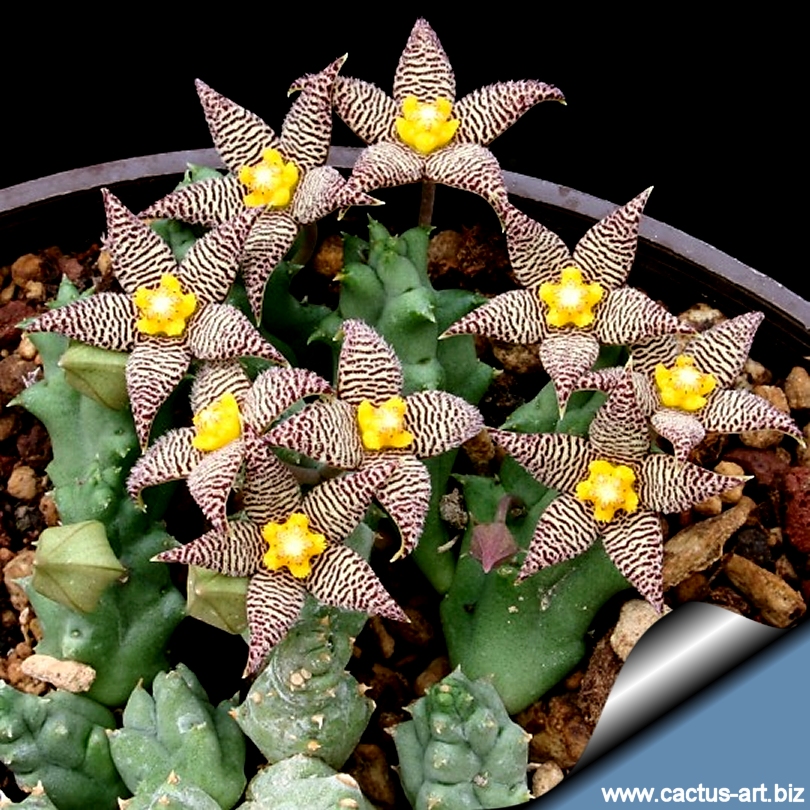
Piaranthus geminatus
|
|
Description:
Clumping and
prostrate species that spread over the ground forming large
cushions.
Stems: Procumbent or ascending, divided in short squat
ovoid or cylindrical
articles obtuse to obscurely 4-angled, with 2-4 minute teeth along
each angle. Surface smooth or slightly rough, light-green tips faintly
purple.
Flowers: 1 to 3 (rarely more) in a short inflorescence, Flowers
are valerian scented with fruity component about 13 mm to 42 mm in
diameter,
star-shaped, more or less
pubescent, and
velvety the colour of the open corolla varying from whitish,
yellowish, reddish or bright brown, with or without brown-red dots or
transverse lines (sometime condensed to a more or less plain
colouration) margin recurved. Corona yellow, unspotted. Tube absent.
Peduncles 2-20 mm long x 1-2 mm in diameter, sepals 2-4 mm long.
Blooming season: Produces numerous flowers simultaneously in
October.
Taxonomy remarks : The
genus Piaranthus is a very confusing
complex of extremely nearly related
species with many intermediary
forms growing together in many widespread
localities and they are very difficult to distinguish. Also
experienced
botanist found difficulty to separate and
classify reliably the various species and forms.
In particular
Piaranthus geminatus var. geminatus is a very variable species
which now also includes the former species
P. globosus, P.
disparilis, and P. pillansii.
Pollination: This plat are pollinated by
flies (myiophilous
pollination). Fly are attracted by olfactory
stimuli, imitating dung or
decaying
organic (zoogenic
or
phytogenic)
matter, together with
mimetic colouration and, sometimes mimetic sculpturing.
Nectar is present. The nectar mainly serves as optical
attractant causing brilliance effects, and as visitor guide.
However, nectar obviously is also a reward. In the pollination process
flies carry
pollinaria only at the distal parts of their proboscis, never on
their legs. The pollinator spectra are similiar between of flowers in
habitat and cultivated ones.
|
|
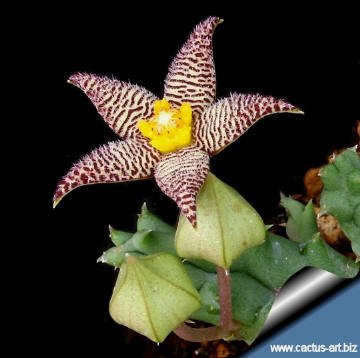 |
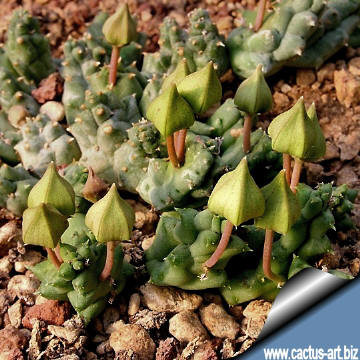 |
|
Cultivation: It is an easy
blooming plant when
mature that require moderately watering through the
growing season but enjoy plenty of water and some
fertiliser in hot
weather, this helps them to
flower freely. Water more sparingly in winter according to
temperatures. But, as with most
asclepiads, it is unwise to leave them wet in cold weather.
Winter care presents no problems at 5°C with plenty of light. Since
roots are quite shallow, use a
cactus mix or add extra
perlite or
pumice to regular soil
potting soil. A gritty, very free-draining
compost is suitable, and
clay pots help the plants to dry out between watering.
Sun Exposure: Partial sun or
light shade
Pest and
diseases: Stapelia species vary in their
susceptibility to
rotting, but are generally fairly easy to grow, especially
if kept
pest-free. They are very
susceptible to stem and root
mealy bugs, and damage from these may well initiate
fungal
attack. If you do have problems with a stem or with basal
rotting, you can reliably isolate the
healthy parts, dry them off, and
re-root them in moist
compost.
Cultural Practices:
Re-pot every 2 years
Propagation:
Easiest with stem
cuttings. Allow cuttings to
dry a day before
planting. Stems must be laid (Not buried) on
gritty
compost and will then
root from the underside of the
stems. It can also be increased from seeds
sowing in
spring in moist,
sandy
peat moss.
Potting medium:
Since roots are quite shallow, use a
cactus mix or add extra
perlite or
pumice to regular soil
potting soil. A gritty, very free-draining
compost is suitable, and
clay pots help the plants to dry out between watering.
|
|
Advertising


|
|
|
|
Family:
Asclepiadaceae (Apocynaceae)
(Milkweeds family)
Scientific Name:
Piaranthus geminatus
(Masson) N.E.Br. . subsp. geminatus
Origin: Eastern and Western
Cape Provinces
Synonyms:
- Caralluma geminata (Masson)
Schltr. fide White A. & Sloane B. L.
Published in:The
Stapelieae vol 2 p 808
- Obesia geminata (Masson) Haw.
fide White A. & Sloane B. L.
Published in:The
Stapelieae vol 2 p 808
Piaranthus barrydalensis Meve fide Bruyns
In Stapeliads 2: 358 (2005).
Piaranthus disparilis N.E.Br.
Piaranthus disparilis N.E.Br. var. immaculata C.A.Lückh.
Piaranthus foetidus N.E.Br. fide Bruyns
In Stapeliads 2: 358 (2005).
Piaranthus foetidus N.E.Br. var. diversus fide Bruyns
In Stapeliads 2:
358 (2005).
Piaranthus foetidus N.E.Br. var. multipunctatus fide Bruyns
In Stapeliads 2: 358 (2005).
Piaranthus foetidus N.E.Br. var. pallidus fide Bruyns
In Stapeliads 2:
358 (2005).
Piaranthus foetidus N.E.Br. var. purpureus fide Bruyns
In Stapeliads
2: 358 (2005).
Piaranthus geminatus (Masson) N.E.Br. var. foetidus (N.E.Br.) Meve
fide Bruyns
In Stapeliads 2: 358 (2005).
Piaranthus globosus A.C.White & B.Sloane
Piaranthus pillansii N.E.Br.
Piaranthus pillansii N.E.Br. var. inconstans
Podanthes geminata (Masson)G.Nicholson fide White A.&Sloane B.
L. In: The Stapelieae vol 2 p 808
Stapelia geminata Masson
|
|
|
|
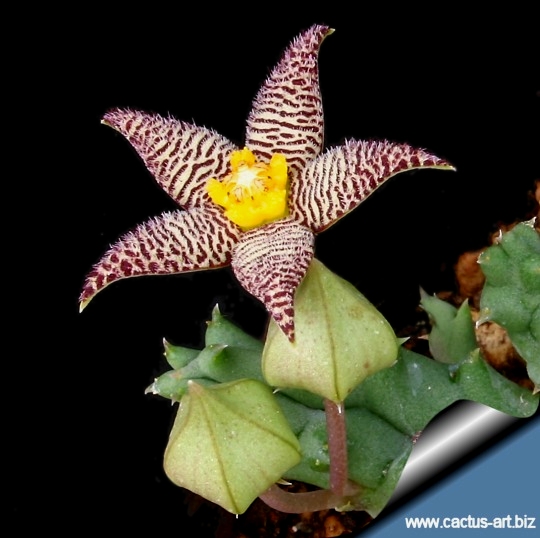
Flowers about 2 cm in diameter,
star-shaped,
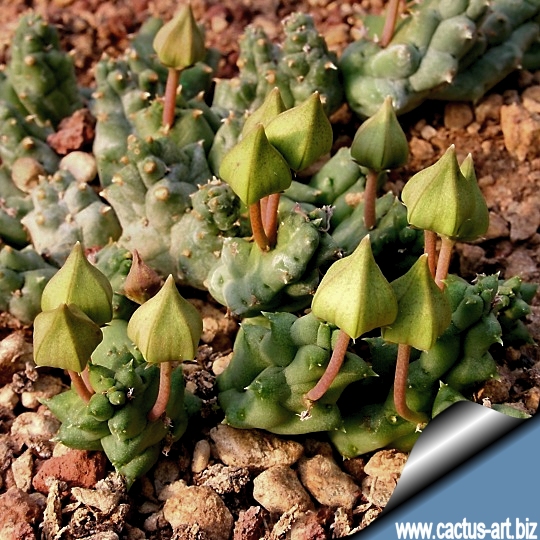
Buds
Photo of conspecific taxa, varieties,
forms and cultivars of Piaranthus geminatus.
This
Taxon has lots of synonyms ( like
many other stapeliads) whit several controversial varieties and
subspecies and comprises a multitude of different forms, but where each
form is linked to others by populations of plants with intermediate
characteristics:
|
|